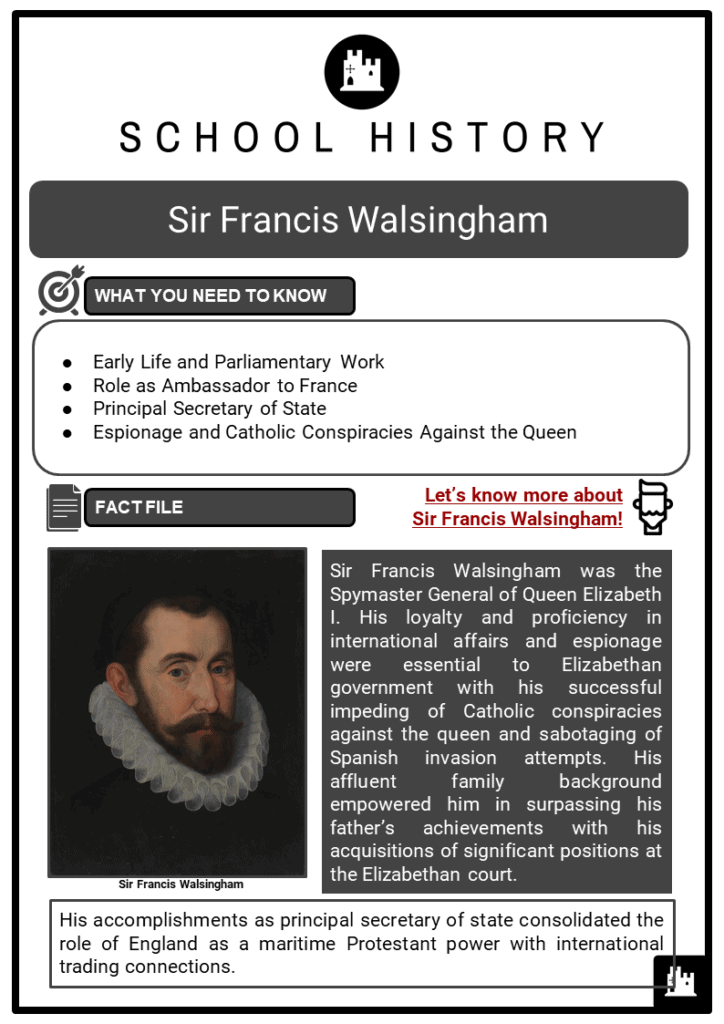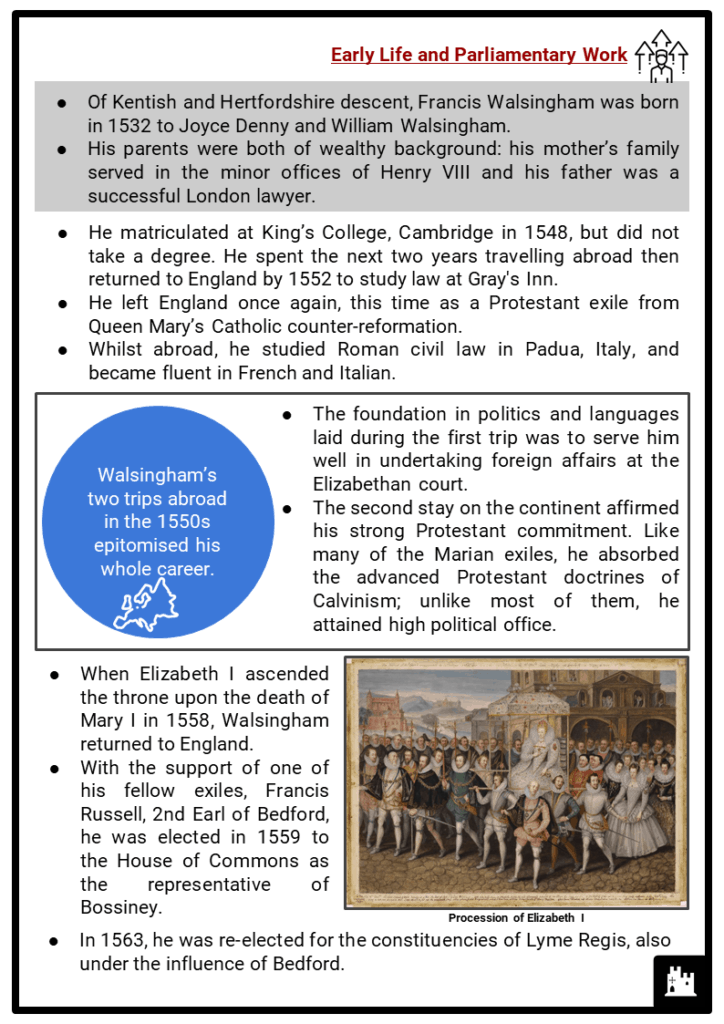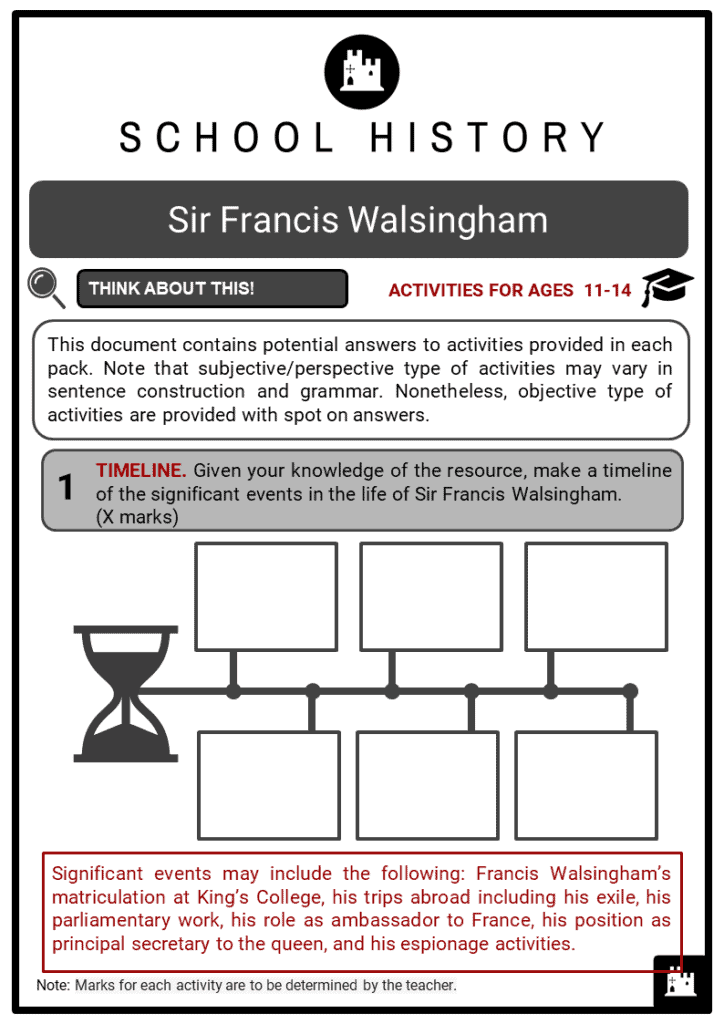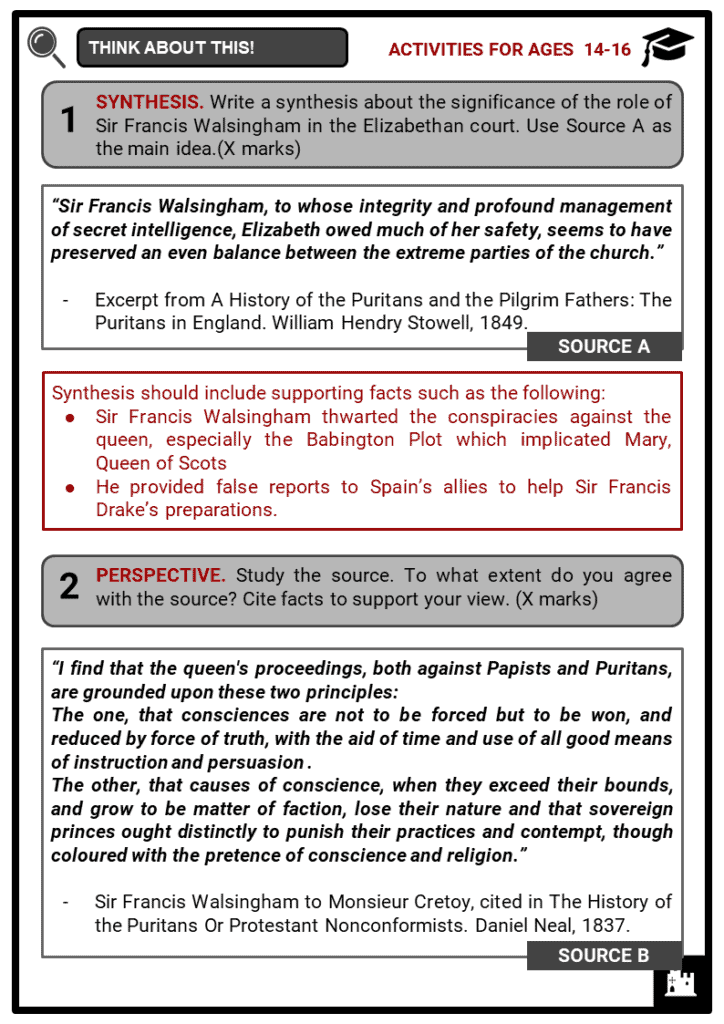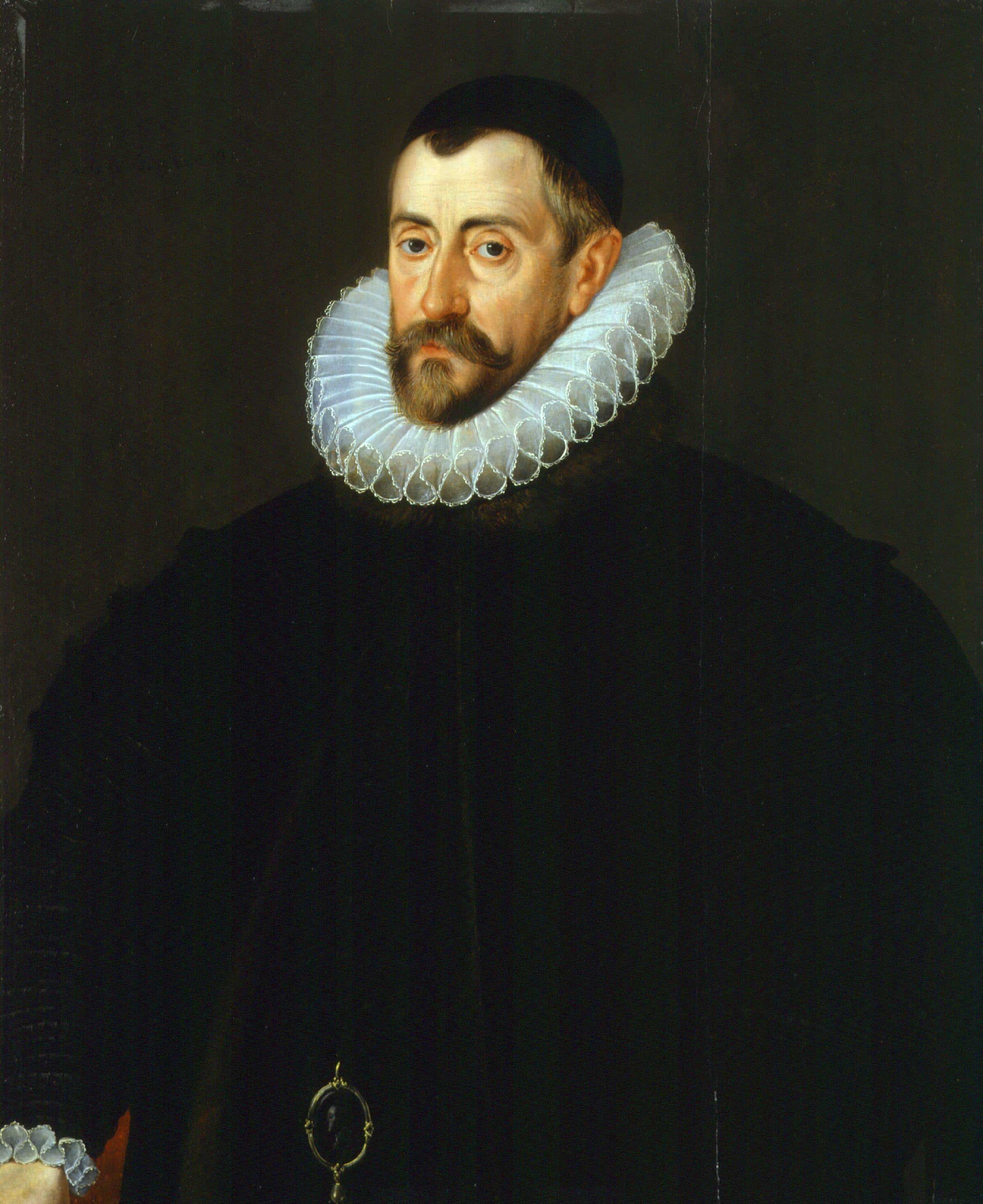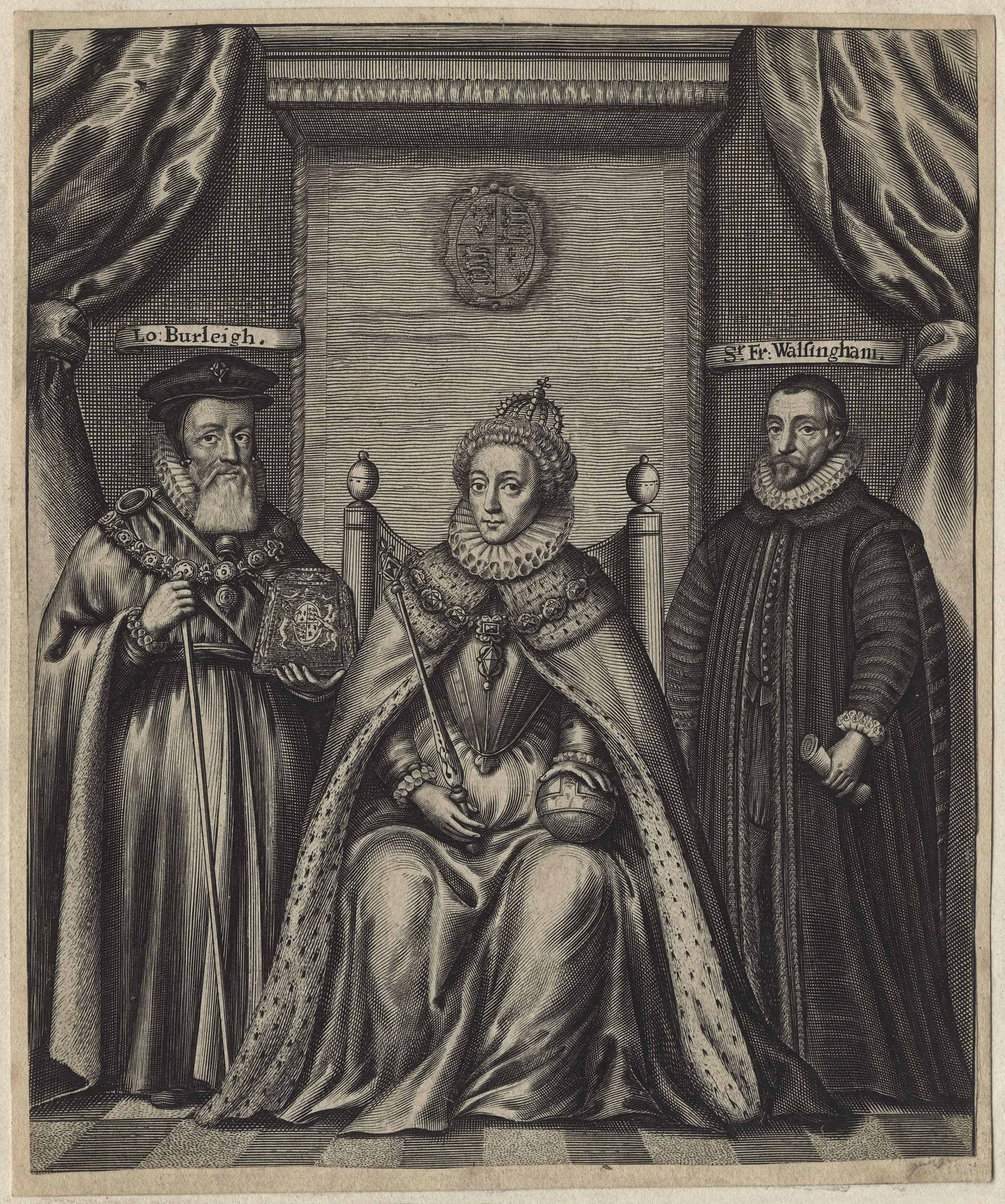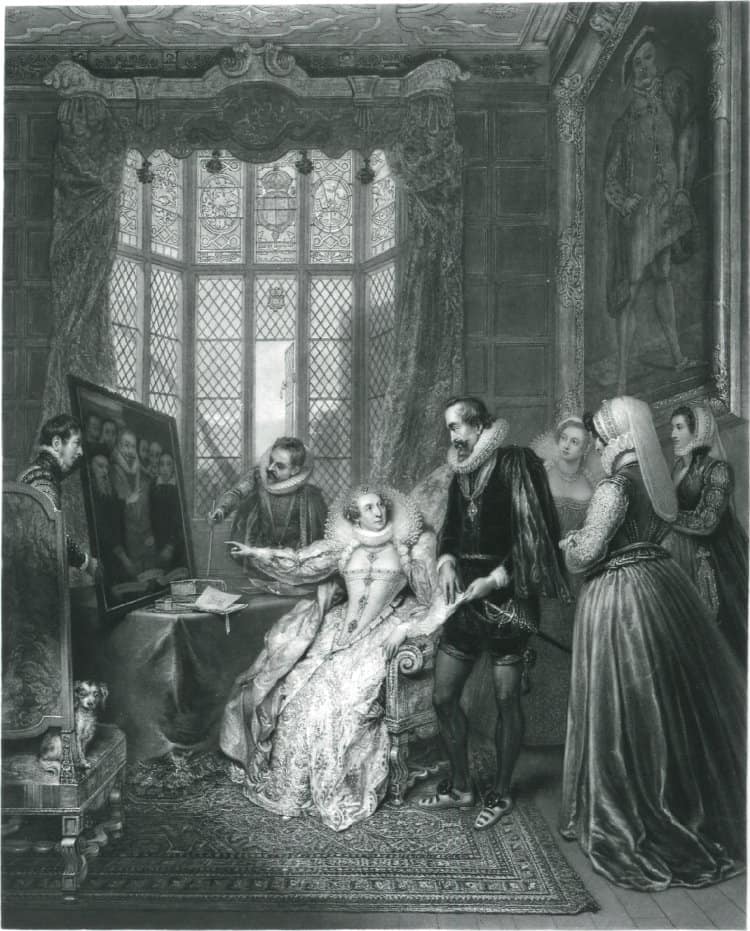Download Sir Francis Walsingham Worksheets
Do you want to save dozens of hours in time? Get your evenings and weekends back? Be able to teach Sir Francis Walsingham to your students?
Our worksheet bundle includes a fact file and printable worksheets and student activities. Perfect for both the classroom and homeschooling!
Table of Contents
Add a header to begin generating the table of contents
Summary
- Early Life and Parliamentary Work
- Role as Ambassador to France
- Principal Secretary of State
- Espionage and Catholic Conspiracies Against the Queen
Key Facts And Information
Let’s know more about Sir Francis Walsingham!
- Sir Francis Walsingham was the Spymaster General of Queen Elizabeth I. His loyalty and proficiency in international affairs and espionage were essential to Elizabethan government with his successful impeding of Catholic conspiracies against the queen and sabotaging of Spanish invasion attempts. His affluent family background empowered him in surpassing his father’s achievements with his acquisitions of significant positions at the Elizabethan court.
- His accomplishments as principal secretary of state consolidated the role of England as a maritime Protestant power with international trading connections.
Early Life and Parliamentary Work
- Of Kentish and Hertfordshire descent, Francis Walsingham was born in 1532 to Joyce Denny and William Walsingham.
- His parents were both of wealthy background: his mother’s family served in the minor offices of Henry VIII and his father was a successful London lawyer.
- He matriculated at King’s College, Cambridge in 1548, but did not take a degree. He spent the next two years travelling abroad then returned to England by 1552 to study law at Gray's Inn.
- He left England once again, this time as a Protestant exile from Queen Mary’s Catholic counter-reformation.
- Whilst abroad, he studied Roman civil law in Padua, Italy, and became fluent in French and Italian.
- Walsingham’s two trips abroad in the 1550s epitomised his whole career.
- The foundation in politics and languages laid during the first trip was to serve him well in undertaking foreign affairs at the Elizabethan court.
- The second stay on the continent affirmed his strong Protestant commitment. Like many of the Marian exiles, he absorbed the advanced Protestant doctrines of Calvinism; unlike most of them, he attained high political office.
- When Elizabeth I ascended the throne upon the death of Mary I in 1558, Walsingham returned to England.
- With the support of one of his fellow exiles, Francis Russell, 2nd Earl of Bedford, he was elected in 1559 to the House of Commons as the representative of Bossiney.
- In 1563, he was re-elected for the constituencies of Lyme Regis, also under the influence of Bedford.
- In January 1562, he married Anne, daughter of Sir George Barne, Lord Mayor of London, and widow of a wine merchant, Alexander Carleill.
- She died two years later and her son Christopher Carleill was placed under Walsingham’s tutelage.
- In 1566, Walsingham married Ursula St Barbe, widow of Sir Richard Worsley.
- Through this marriage, he acquired the estates of Appuldurcombe and Carisbrooke Priory on the Isle of Wight.
- The following year their daughter Frances was born. Ursula had two sons from her previous marriage, John and George, who were killed in 1567 in an explosion of gunpowder at Appuldurcombe.
- In the years that followed, Walsingham actively supported the French Huguenots and developed a close and friendly working relationship with Nicholas Throckmorton, the former representative of Lyme Regis and ambassador to France.
- In 1568, Walsingham started performing confidential tasks for Sir William Cecil, Elizabeth’s principal secretary, to thwart conspiracies against the queen.
- When vague reports surfaced about plans for a change in religion and succession of Mary, Queen of Scots to the English throne, he wrote to Cecil: There is lesse daynger in fearinge to much then too little.
- He was credited with writing a propaganda text describing a conspiratorial alliance between Mary, Sir Thomas Howard and Roberto di Ridolfi.
- He later found out the Ridolfi plot, which was supported by the papacy, the bishop of Ross, and a group of English Catholic lords, and which sought to replace Elizabeth with Mary, Queen of Scots.
Role as Ambassador to France
- In 1570, the queen chose Walsingham to support the Huguenots in France in their negotiations with Charles IX.
- Later that year, he replaced Sir Henry Norris as ambassador in Paris.
- One of his first actions was that of continuing the negotiations for a marriage between Elizabeth and the future Henry III. However, such a plan was abandoned because of the religion of the then Duke of Anjou.
- An alternative potential husband was the youngest son of Henry II, Francis, Duke of Alençon.
- Yet, Walsingham considered him unpleasant and devoid of good humour. Elizabeth was twenty years older than the Duke of Alençon and she was concerned that this age difference might seem strange.
- Walsingham thought England should seek a military alliance with France against Spanish interests.
- Thus the defensive Treaty of Blois was concluded in 1572, but since it did not include provisions on marriage, it left open the question of Elizabeth’s succession.
- The Huguenots and other European Protestants supported the emerging revolts in the Spanish Netherlands.
- When the opposition of the Catholics led to the death of Huguenot leader Gaspard de Coligny and the massacre on St. Bartholomew’s Day, Walsingham’s Parisian home temporarily became a refuge for Protestants such as Philip Sidney.
- Walsingham’s wife, Ursula, then pregnant, fled to England with their four-year-old daughter.
- In January 1573, she gave birth to their second daughter, Mary.
- Walsingham returned to England in April, having proved his loyalty and competence to be trusted by Cecil and the queen.
- A few months earlier, in 1572, Walsingham was elected to Parliament in the Surrey district.
- Whilst he was not a major parliamentarian, he kept this seat until his death.
- In December 1573, he was appointed to the Privy Council as Principal Secretary with Sir Thomas Smith.
- After the latter’s withdrawal in 1576, he took effective control.
- Francis Walsingham was knighted on 1 December 1577.
Principal Secretary of State
- When he was made principal secretary of state, Walsingham dealt with all the royal correspondence and determined the agenda of Council meetings.
- He demonstrated a great influence on all internal and foreign political questions whilst undertaking and supporting various endeavours.
Exploration
- Walsingham actively supported trade promotion projects and invested in the Muscovy and Levant companies.
- He also supported attempts by John Davis and Martin Frobisher to discover the Northwest Passage and exploit Labrador’s mineral resources, and encouraged Humphrey Gilbert to explore Newfoundland.
- Gilbert’s trip was largely funded by the Catholic recusants and Walsingham supported the project as a potential means of suppressing Catholicism in England by encouraging the emigration of Catholics to the New World.
International relations
- Walsingham was directly involved in political and diplomatic relations with Spain, the United Provinces, Scotland, Ireland and France, notably by participating in several missions in neighbouring states.
- He was sent to the Netherlands to collect military intelligence and to possibly negotiate a peace deal.
- He reluctantly visited the Scottish court to secure a pro-English government but James VI dismissed Walsingham’s advice.
- He was commissioned but unsuccessful to secure the Anglo-French alliance by obtaining a treaty with the possibility of marriage between Elizabeth and Duke of Alençon.
Support for Puritans
- Walsingham used his position to aid the Puritans in the Church of England who felt that the Reformation had not gone far enough.
- The harsh treatment of the Puritans by Archbishop John Whitgift in the 1590s, after Walsingham’s death, testified to how effectively the secretary had shielded them from Elizabeth’s distaste and her prelate’s wrath.
Plantation in Ireland
- Walsingham arranged the cultivation of land in Ireland to improve the productivity of estates, believing that Irish farmland was underdeveloped.
- However, tensions between the native Irish and the English settlers arose and had lasting effects on the history of Ireland.
Espionage and Catholic Conspiracies Against the Queen
- Walsingham’s most known work was as an intelligence agent and counterspy which earned him the title Spymaster General.
- In the two decades following 1570, when Protestant England’s survival was threatened by external invasion from Spain and internal subversion by Jesuit missionaries working with a radical fringe of English Catholics, his espionage network in the continent and secret-service surveillance of Roman Catholics in England proved vital.
- Until 1587, the main hope of the papacy and Spain lay in the possibility that Elizabeth might be assassinated by conspirators or deposed by a Catholic uprising, thus placing on the throne the deposed Catholic, Mary, Queen of Scots.
- Walsingham and his agents frustrated these Catholic plots, decisively establishing the complicity of Mary in some of them.
- Walsingham brought together an extensive network of spies and news gatherers in France, Scotland, the Low Countries, Spain, Italy, and even Turkey and North Africa.
- The conspiracy that ultimately led to Mary’s trial, conviction and execution was the Babington Plot that was exposed in August 1586.
- Walsingham’s double agents and code experts supplied the coded letters smuggled inside a beer barrel as the means of communication between Mary and the conspirators.
- These letters established Mary’s involvement in the effort to overthrow the queen.
- Mary’s execution in 1587 was promoted in large part by Cecil and Walsingham. The latter did not only provide the evidence but also played a major role in the three years of machinations necessary to persuade Elizabeth to sign Mary’s death warrant.
- With Mary’s death, the papacy and Spain hoped for the success of the Great Enterprise against England.
- The Spanish Armada, already in preparation when Mary died, was launched the next year.
- Walsingham’s continental network aided in the preparations of Sir Francis Drake’s surprise raid on Cádiz harbour in April 1587 by providing false intelligence reports to Spain’s allies.
- This enabled England to counteract the diplomatic activities of Spain and to assess her intentions and the state of her preparations.
- Walsingham had been complaining about his ill health since 1571.
- His health suffered and failed, and on 6 April 1590, he passed away in his house at Seething Lane.
- He was buried in Old St. Paul’s Cathedral: his grave was to be destroyed in the Great Fire of London in 1666.
Image sources:

